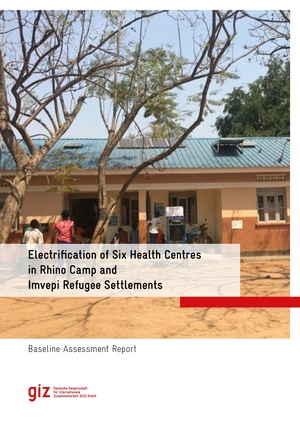Difference between revisions of "Electrification of Six Health Centres in Rhino Camp and Imvepi Refugee Settlements"
***** (***** | *****) m (The study report) |
***** (***** | *****) (Electrification of Six Health Centres in Rhino Camp and Imvepi Refugee Settlements) |
||
| Line 2: | Line 2: | ||
=='''Background'''== | =='''Background'''== | ||
| − | The GIZ projects Energy Solutions for Displacement Settings (ESDS) and Energising Development (EnDev) intended to provide and install OGS PVS for | + | Uganda is one of the twenty countries with the largest population that lacks access to electricity, with only 43% of the population having access. The importance of reliable, sustainable and accessible energy for health centres is undebatable. Based on the results from the 2007 Uganda Service Provision, 58% of health facilities did not have access to electricity and only 15% had “reliable” electricity. When further disaggregated by type of health facility, 60 % of lower-level health facilities lack access. Given this background, the GIZ projects Energy Solutions for Displacement Settings (ESDS) and Energising Development (EnDev) intended to provide and install OGS PVS for 6 purposefully selected health centres located within Rhino Camp and Imvepi Refugee Settlements in Terego and Madi Okollo districts of Uganda in 2021. This article provides a summary of the baseline assessment results that was conducted in 2021 prior to the electrification of these six health centers. |
| − | + | == Baseline Assessment Results == | |
| − | |||
| − | |||
Revision as of 14:17, 29 September 2022
Background
Uganda is one of the twenty countries with the largest population that lacks access to electricity, with only 43% of the population having access. The importance of reliable, sustainable and accessible energy for health centres is undebatable. Based on the results from the 2007 Uganda Service Provision, 58% of health facilities did not have access to electricity and only 15% had “reliable” electricity. When further disaggregated by type of health facility, 60 % of lower-level health facilities lack access. Given this background, the GIZ projects Energy Solutions for Displacement Settings (ESDS) and Energising Development (EnDev) intended to provide and install OGS PVS for 6 purposefully selected health centres located within Rhino Camp and Imvepi Refugee Settlements in Terego and Madi Okollo districts of Uganda in 2021. This article provides a summary of the baseline assessment results that was conducted in 2021 prior to the electrification of these six health centers.





















